|
|
 |
|
|
PowerX2011™ advanced telecom
server is an intelligent multi-channel communication server that not only
incorporates all the functions found in a sophisticated telephone system such
as a PABX with its advanced add-ons but also much more advanced, useful and
unique features in a single, compact, low cost, easy to maintain and completely
integrated platform. It is a network ready telecom and computer telephony
server providing telecommunication & computer telephony integration (CTI)
such as advanced PABX switching, intelligent automatic call distribution (ACD),
conversation recording, call details recording, auto attendant, unified
messaging, interactive voice response (IVR) system, text-to-speech and speech
recognition technology, least call routing, voice-over-Internet-Protocol
(VoIP), SMS, Email, Fax, internet chat and more.
|
|
It is designed to be an open and flexible system which can be customized and
integrated with other applications to meet specific market demands including
online real time transaction processing through the use of IVR, credit card
payment processing, real-estate property listings, internet chat, internet
call, Contact Centers, etc.
PowerX2011™ telecom server is the most modern, open, flexible
and universal telecom server. As all the advanced telecommunications and
computer telephony features are designed to work together as an all-in-one
total communications solution, it removes the necessity to purchase several
systems such as PABX, Key Telephone System (KTS), voice mail, auto attendant,
IVR, call accounting, conversation recording, CTI server, ACD or unified
messaging.
It serves as a foundation for CTI seamless integration with the PowerX
Relationship Management Platform and other Customer Relationship Management
(CRM) applications in the market to deliver a state-of-the-art total
communication solution. Independently, the PowerX2011™ telecom
server provides true end-to-end CRM capabilities without the need to integrate
multi-vendor subsystems to the traditional telephone/PABX system.
|
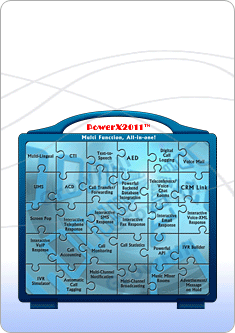 |
|
|
Unlike the traditional PABX and ACD systems, the PowerX2011™ telecom
server extends beyond incoming and outgoing calls. It not only empowers all
functions of a sophisticated traditional telephone/PABX system to be configured
and managed from a single graphical user interface (GUI) of the computer, it
also links the switches of the computer to manage the flow of information
between the telephone and the computer. It handles most types of communication
channels such as voice calls, voice mail, internet calls, web chat, SMS, fax
and email by intelligently queuing, distributing and tracking each type of
communication events to Automatic Event Distribution workgroup(s). This feature
helps agents to multi task customer requests using different communication
modes, track responses and service levels for each type of communication
channel and improve productivity.
It also applies intelligence to phone call handling to automatically add
relevant data, fax, graphics and/or video to voice communication.
The PowerX2011™ telecom server is also a comprehensive contact
management center offering a complete range of solutions. It is fully scalable
and designed to meet the operational needs of businesses from small enterprises
to large multinational corporations and Contact Centers. The system comes
complete with the latest telecom, optional computer telephony and IP technology
and features its own unique and powerful computer telephony application.
Like its open design software, its operability and growth is not
constrained by any hardware.
The PowerX2011™ telecom server can be deployed at a cost of at
least 50% lower than any traditional PABX solution. There is no
duplication in hardware resources and no third
party system involved in providing even sophisticated
telecommunication features such as Short Message Send service (SMS)
broadcasting and CTI capabilities.
With the PowerX2011™ telecom server, there is also no
duplication of software resources; one fully integrated
platform for all features .
It is 100% compatible as the hardware and software are built
from ground up to match and work with each other.
The user is not locked in to proprietary equipment
as the PowerX2011™ telecom server supports all standard caller
ID handsets.
As free software upgrades are provided during the
maintenance period, all customers enjoy the latest available software features
and this increases the lifespan of the system.
There are no multi subsystems to deliver advanced
telephony features, which limits hardware parts for maintenance and upgrades.
It is scalable to 5,072 ports (Trunks + Extensions)
and can be cascaded to provide as high as 50,000 ports. There is
no restriction on the number of available voicemail ports,
conversation recording ports, ACD groups/members and IVR menus as the PowerX2011™
is designed based on powerful one-to-one allocated resources unlike limited
shared resources in traditional telephone/PABX solutions.
It leverages on the power of the industrial 19” rack mounted computer, together
with the latest communications technology, to maximize company’s productivity
and control costs. It is fully expandable.
As the PowerX2011™ telecom server is mostly managed by its
powerful software, there is no additional floor space
required for incorporating new features.
Its modular and open system design enables tremendous
flexibility in customization and creation of powerful unique
solutions.
The PowerX2011™ telecom servers in the main building and annex
can function as a unified PABX system or split into a few independent systems.
In the event of physical relocation of a major division, the servers
can be split up into more than one standalone or integrated system.
There is no need to purchase additional PABX system to support the division
that is relocating.
There are lower maintenance costs as there is only one
platform to support and customize.
There is only one point of contact for support and
customization as there are no multiple vendors to deal with.
There is less reliance on vendor to implement minor changes to system
configuration. Graphical based administrator module empowers
any trained IT staff/administrator to make changes to system configuration,
design new IVR menus, etc.
There are no hidden costs as all software upgrades
are free during the maintenance period and there is no subsequent charge for
customization or configuration change. (IVR changes, configuration changes,
call flow modification, etc.)
Continued support is not an issue as the PowerX2011™ telecom
server uses market available standards such as Ms WindowsÒ based interface,
standard analog and/or featured handsets, Crystal Reportsâ
and ODBCâ
compliant databases for CTI.
Since the system is compact and mobile, in the event of disaster,
telecommunication services normally resumes after a few hours
. Also a low cost redundant system can be deployed easily.
A loan system is also made available in the event
of disaster.
The PowerX2011™ telecom server has a built-in
interface which can directly link to any ODBC compliant database
and/or CRM/ERP system to deliver services such as screen popups,
reading/updating transactions such as account balances, etc.
The system is designed to manage multi-channel communications; voice calls,
voice-over-IP calls, SMS, fax, email, web chat and video conferencing. It
allows for multi channel broadcasting and
notification services. It also supports multiple incoming
channels through its powerful Automatic Event Distribution feature.
The PowerX2011™ telecom server offers a greater
exhaustive range of advanced PABX features such as CTI, multi
channel communication management (voice, fax, email, internet calls, web chat)
and unified messaging (voice mail, fax and email).
|
|

|
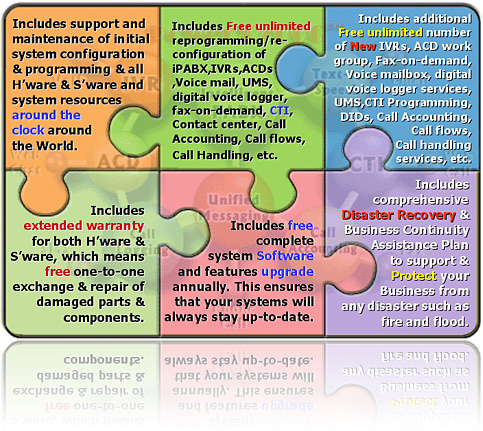
|
|
| Top |
|
|
|
|
|
|
|
|
| |

|
| |
|
The traditional Public Automatic Branch eXchange or PABX is an automatic
telephone switching network within a private enterprise. A traditional PABX
system comprises a control box, master operator console and extension handsets.
An operator is required to control the switchboard and physically connect
incoming telephone calls to each extension.
The main function of a traditional PABX is to extend the trunk lines of the
company to a group of users (extensions). It focuses on incoming and outgoing
calls.
In order to meet today's rising business demands, some vendors bundle optional
external add-ons which includes third party solutions into the main telephone
system to provide services such as voicemail, call accounting, ACD (automatic
call distributions), etc. As a result of these add-ons, the following services
may be provided but with limited functionalities:
|
|
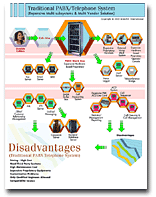
Click to view the pictures
|
|
|
|
| |

|
| |
|
The PowerX2011™ telecom server is a sophisticated
multi-channel telecommunication network that can effectively scale to meet the
needs of any organization, regardless of size. Incoming communication is
electronically channeled to the desired extension and no operator is required
to man any central control switchboard.
|
|
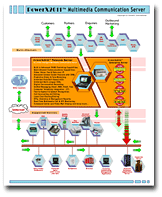
Click to view the pictures
|
|
| |

|
| |
| Comparison
|
Traditional PABX
Solution
|
PowerX2011™
Telecom Server
|
Cost Effectiveness
|
|
The traditional PABX system is a dedicated phone
network system.
In order for the traditional PABX solution to
offer features such as voicemail, interactive voice response (IVR), automatic
call distribution (ACD), reporting and call accounting, it requires third party
subsystems to be connected to the main PABX box for each of these features.
Each of these subsystems requires its own set of hardware and software. This
leads to duplication of hardware and resources. Resources include floor space,
electricity, software like operating system, anti-virus software, PABX ports
and extensions for connection purposes.
For example, the company must purchase
additional hardware such as special line cards for the ACD hardware, call
queuing management system, hardware and software for the ACD. There may also be
a requirement to upgrade the operating system of the PABX. These translate to
higher initial and running costs.
The company also ends up with more hardware and
software than is required for each additional feature desired. This adds to the
incurring of unnecessary expenditure for the additional features.
|
|
|
The PowerX2011™ telecom server
is an all-in-one system. There is no subsystem involved. All features are
integrated into the same system..
The company does not need to pay for duplicate
hardware and resources.
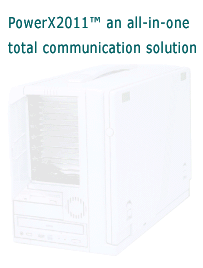
|
|
Pricing
|
|
The traditional PABX solution consists of a PABX
box connected with third party subsystems such as voice logger, voicemail,
interactive voice response (IVR), call sequencer, statistical reporting system
and call accounting.
|
|
|
Feature for feature, the PowerX2011™
telecom server is at least 50% more attractively priced compared with the
traditional PABX solution.
|
|
Running Costs
|
The additional routing due to the external
nature of the subsystems and the resultant delays results in the company
spending more costs in terms of power consumption, maintaining complex and
additional multi vendor infrastructures, hardware and software, hiring more
agents and subscribing to more trunk lines.
|
|
|
The elimination of delays translates to huge
savings in the hiring of additional agents and subscription of trunk lines.
There is only one system to maintain so it saves costs for the company in terms
of power consumption and maintenance costs.
|
|
Maintenance Cost
|
The add-on subsystems and the main PABX system
are from different vendors. Hence a multi-vendor environment is created.
Maintenance costs are higher due to the need to
support the main PABX system as well as the add-on subsystems.
|
|
Feature for feature, the PowerX2011™
telecom server is at least 50% more attractively priced compared with the
traditional PABX solution.
|
|
Compatibility
|
As each add-on subsystem comes from a different
vendor from the main PABX system, they cannot be fully compatible with each
other. As a result, the company cannot maximize the enjoyment of all the
features each subsystem can offer.
|
|
There is no compatibility issue (that is, 100%
compatible) as the hardware and software are built ground up to match each
other in the PowerX2011™ telecom server.
|
|
Advanced PABX Features
|
The traditional PABX, on its own, is a dedicated
phone network. It only serves to connect incoming calls from trunks to internal
extensions and outgoing calls from internal extensions to trunks.
Even today, most PABX solutions still do not
have all the comprehensive features offered by the PowerX2011™ telecom server
in one platform.
|
|
The PowerX2011™ telecom server
is able to provide advanced features such as CTI (Computer Telephony
Integration), multi-channel communication management (voice, fax, email,
internet calls, web chat) and Unified Messaging (voicemail, fax and email).
Unlike the multi-vendor environment of the
traditional PABX solution, the features are built into the system.
|
|
Direct Linkage to CRM/ERP Applications
|
In the traditional PABX solution, CRM and ERP
applications are third party software. Any linkages have to be carried out
through third party interfaces.
|
|
|
The PowerX2011™ telecom server
has a built-in interface which can link to any ODBC-compliant CRM/ERP system to
deliver services such as screen popups, reading and updating of transactions
for example account balance, etc.
|
|
Multi-Channel Communication
|
The traditional PABX is mainly designed to
handle voice calls only.
|
|
|
The PowerX2011™ telecom server
is designed to manage multi-channel communication. This includes voice call,
voice-over-Internet-Protocol, SMS, fax, email and web chat.
It allows for multi-channel broadcasting and
notification services too.
It also supports multiple channels through the
AED (Automatic Event Distribution) feature.
|
|
Any special hardware
|
As the traditional PABX system has to bundle
with third party hardware and software in order to offer advanced features such
as ACD, the extent of integration and equipment to be purchased is subject to
constraints from both systems. For instance, the third party ACD can only work
with special line cards and call sequencer to connect the automatic call
distribution system to the main PABX system.
Hence purchasing a third party subsystem alone
is insufficient. It also entails purchasing of other auxiliary
equipment/hardware (could also be third party) to enable it to work with the
PABX.
|
|
|
All features such as ACD form part of the PowerX2011™
telecom server so no other hardware or software is required.
|
|
Robustness
|
After spending all the additional money to add
on the capabilities of the subsystem, there is still no assurance that the
configuration would generate optimal results.
As a general rule, running multi-vendor,
multi-system solutions normally result in a drop in the quality of service,
difficulties in upgrading and limited flexibility in configuration.
|
|
|
The quality of service provided by PowerX2011™
Telecom Server is higher and the solution is generally more robust. This is
because there is no reliance on multi-vendor, multi-system solutions.
|
|
Reliability
|
The external nature of the subsystem in a
traditional PABX solution poses some issues which affects the reliability of
the overall system for example subsystems which require real time data.
The data which the PABX sends to the Call
Accounting subsystem and any reporting subsystems, for instance, is based on
real time.If the subsystem is down, it cannot receive the data and the data is
lost forever.
To overcome this problem, third party systems
are installed as buffer boxes to collect any overflow data. Once the buffer is
full or if the buffer system fails, data is lost again.
The system failure may go unnoticed until it is
time for the administrator to collect routine reports or call accounting data
from the subsystem and this usually only occurs at the end of the month. By
then, the lost is too great!
|
|
|
The PowerX2011™ telecom server
provides automatic back-ups.
Its also has built-in notification options and
offers a list of communication channels for alerts to be sent.
|
|
Scalability
|
In the traditional PABX solution, each subsystem
is an external entity from the main PABX system. It connects to the ports in
the main PABX system via extension lines.
This strains the already limited resources in
the main PABX system. As more features are offered, more cards need to be added
to the PABX to cater to the increased requirements.
There are limited ports and card slots on the
PABX. When the available card slots are
used up, PABX expansion modules (boxes) need to be added to provide more ports
and extensions.
Unfortunately not all PABX can be expanded. In
such cases, the entire PABX system has to be revamped and replaced with a new
PABX system which can support a higher capacity. Besides incurring costs for
the purchase, installation and commissioning of a new PABX system, the user has
to incur costs to remove the existing PABX system off site. When this happens,
the existing PABX system becomes a white elephant and new proprietary equipment
such as handsets have to be purchased for the new telephone system. Proprietary
handsets are usually costly.
For the PABX systems which can be expanded,
there is always a ceiling to the total number of extensions it can provide.
Once the limit is reached, the system has to be revamped and replaced too.
Hence such systems do not scale easily.
|
|
|
The PowerX2011™ telecom server
is scalable up to 5,072 ports.
|
|
Flexibility vs Constraints
|
The traditional PABX solution is a
hardware-driven solution. In order to offer features such as ACD, hardware such
as call sequencer (complete with accompanying software) need to be installed as
external subsystems to tap onto the main PABX system.
Each PABX main system consists of limited card
slots for each type of cards. To evaluate whether a particular feature can be
offered, it also depends on, amongst other factors, the number of available
card slots for, say, ACD in the existing PABX. There are also physical
restrictions as to how many agents each card can support.
For example in the case of ACD, at the very
best, each special card can only cater to a maximum of 25 agents. If the
Contact Center has 101 agents, it needs to purchase 5 line cards, which
translates to a whole line card for the last agent. This means higher costs and
less flexibility for expansion.
Another setback is that each card can only
support one workgroup. Thus, if you have two workgroups, you will need another
card even when there are enough leftover extensions in the first card to cover
the second workgroup.
|
|
|
All features such as ACD form part of the PowerX2011™
telecom server so no other hardware or software is required.
|
|
Robustness
|
After spending all the additional money to add
on the capabilities of the subsystem, there is still no assurance that the
configuration would generate optimal results.
As a general rule, running multi-vendor,
multi-system solutions normally result in a drop in the quality of service,
difficulties in upgrading and limited flexibility in configuration.
|
|
|
There are no restrictions on the available
voicemail ports, conversation recording ports, ACD workgroups/members and IVR
menus.
There are also no limitations on the number of
extensions or agents that can be created per workgroup.
This represents a huge savings in initial
investment and subsequent maintenance costs.
|
|
Ongoing Support
|
The traditional PABX system is normally closed
to users, that is, it is a ‘black box’ to them.
Most warranties specify that companies (users)
are usually not allowed to ‘touch’ the PABX equipment. These equipment are
usually stored in a dedicated locked room within the company premises and the
key is kept by the PABX vendor. Alternatively the equipment is housed in a
locked cabinet with the key kept by the PABX vendor.
There is heavy reliance on the PABX vendor to
carry out all configurations to the system regardless of simplicity. For
example adding a new member to an existing ACD workgroup can only be done by a
qualified technician supplied by the PABX vendor.
This translates to higher maintenance costs as
such services are usually chargeable. The cost increases when more than one
system is involved.
Time to deliver is also subject to the
availability and schedule of all technicians involved.
|
|
|
There is less reliance on the vendor to
implement minor changes to the PowerX2011™ telecom server
system configuration. The graphical administrative interface empowers any
trained IT staff/administrator to make changes to the system configuration,
design new IVR menus, etc through a series of mouse clicks within a few
minutes.
|
|
Product Lifespan
|
The product lifespan of the traditional PABX
system is limited. The features are usually hardware based. Any upgrade
involves additional hardware which translates to additional costs.
|
|
|
The maintenance for the PowerX2011™
telecom server covers software upgrades.
All customers enjoy the latest available
software features and this increases the lifespan of the system.
|
|
Proprietary Equipment
|
Users of traditional PABX systems are locked in
to the use of proprietary equipment supplied by the PABX manufacturer. Due to
their proprietary nature, they tend to be exclusive and expensive.
One example is the phone handset. The
proprietary handsets supplied for a particular PABX model may not always be
compatible with another range even when both PABX systems are supplied by the
same vendor. Imagine the cost if all the handsets have to be replaced in order
to upgrade to a PABX of higher capacity when the company expands!
|
|
|
The PowerX2011™ telecom server
is built on market available standards such as MS Windowsâ
based interface, Crystal Reportsâ,
ODBC compliant databases for the CTI, and standard analog telephone handsets.
Using the handset as an example, imagine the
amount of savings a company can gain! The handset is the most commonly used
equipment in any telephone network. If a company has 100 extensions, it would
usually need 100 handsets.
|
|
Upgrading and Expansion
|
As this is a hardware-based solution, upgrading
can be both costly and complicated. Growth is also confined to the hardware
constraints of the limited proprietary resources.
The company also needs to factor in time and manpower for upgrading or
expanding the PABX-subsystem capacity. /p>
A significant amount of time will be spent on interface testing amongst the
subsystems. /p>
Software upgrades to the subsystem and PABX are normally chargeable.
|
|
|
The company can carry out its own configuration
for any expansion via the user-friendly GUI and windows® based administrator
application.
|
|
Customization
|
The traditional PABX solution is difficult to
customize due to the multi-vendor environment. Changes to one subsystem may
impact the main PABX system and other subsystems. More than one vendor may be
involved and additional coordination efforts are required from the company
(user) in order to effect a change. This translates to additional costs for the
company.
|
|
The PowerX2011™ telecom
server's design is modular and based on open system standards. This allows
tremendous flexibility in customization.
|
|
Features
|
The external subsystem may not have all the
features offered by the PowerX2011™ telecom server. For example, the third
party ACD in the traditional PABX solution can only provide limited call
distribution rules. There is only one routing rule for most traditional ACDs.
This rule is on a "first-come-first-served" basis.
|
|
|
The PowerX2011™ telecom server
is able to offer many options for each of its features. For example, for ACD,
there are numerous call distribution parameters available and changes can be
made from time to time to select the most appropriate call distribution
parameters. Examples include "most idle first", language preference, "lease
talk time", etc.
As an integrated solution, it is able to offer
greater flexibility and more complex options such as the capability to handle
complex inbound calls based on the extensive call distribution rules. Some of
these rules are impossible to program in a traditional PABX with an ACD add-on.
|
|
Performance
|
As each subsystem is external to the traditional
PABX system, additional routing is required to connect each subsystem to the
PABX.
This results in delays in system calls or data
transfers as the longer distance require more data traveling time.
As features are offered through external
sub-systems in the traditional PABX solution, the performance of these features
are also affected.
For example in the case of ACD, when a call is
received, it is answered by the main PABX system and is placed on hold. The
PABX system then checks with the external subsystem to find the next available
agent. In order to do this, the ACD system has to poll the status of every
agent until the free agent is found.
Once the available agent is located, the ACD
system releases the 'hold' facility on the call and does an internal transfer
to the agent's extension.
This round-trip of checking and transferring
incurs a waiting time for the caller. Note that this waiting period can range
from 20 to 30 seconds per call.
Imagine if 5,000 calls are received per day.
This translates to 28 man-hours or 7 agents. This delay results in a need for
more agents, trunk lines and system resources. The situation is further
compounded when there are more call queues or when the agents are located in
remote sites
|
|
|
The PowerX2011™ telecom server
is a fully integrated all-in-one system managed by the smart IntelliMatriX™
engine.
System calls and data transfers take a much
shorter route as all components are within the same system. Thus they move
faster.
The modules in the PowerX2011™
telecom server also have instantaneous access to the latest system parameters
like number of available agents, updated call traffic information and queuing
parameters. There is no need to poll the availability status from a third party
system.
Using ACD as an example, there is no need for
the system to check on the availability of agent before applying the
appropriate call distribution rule.
The IntelliMatriX™ engine in the PowerX2011™
Telecom Server keeps track of the status of every available extension. For
Contact Centers that span geographical regions, every one of the IntelliMatriX™
engine in each location has instantaneous update of the status of every
extension in the distributed Contact Centers. This results again in seamless
and very fast response whenever the ACD is distributing an incoming call.
The PowerX2011™
telecom server is able to transfer a call based on call type information
without the need to answer and hold the call.
From the above, we can safely conclude that the
speed of distributing an incoming call is significantly faster using the PowerX2011™
telecom server compared with the traditional PABX multi-vendor environment.
|
|
Information Display
|
Information displayed to the agents and
workgroup normally consists of LED displays, basic call statistics reports and
optional agent consoles.
|
|
|
The modules in the PowerX2011™ telecom
server have instantaneous access to the latest system parameters like number of
available agents, updated call traffic information and queuing parameters.
The information can be displayed on LED, LCD or
even over the Internet.
In addition, the PowerX2011™ telecom
server supports extended caller ID information. This means that information
like number of callers in queue, workgroup voice mail etc. can be transmitted
and displayed on standard Caller ID handsets.
|
|
Future Relocation
|
In the event of physical relocation of a major
division, it is not possible to split up a traditional PABX system into
multiple smaller PABXs.
Additonal costs need to be incurred to purchase
an additional PABX system to support that division.
|
|
|
In the case of the PowerX2011™ telecom
server, the telecom servers in the Main Building and Annex can function as one
PABX system or split into a few independent systems.
In the event of physical relocation of a major
division, say 40% of the existing capacity is moving, the servers can be split
up into more than one PABX system.
There is no need to purchase an additional PABX
system to support the division that is relocating.
|
|
Troubleshooting
|
Each subsystem in the traditional PABX solution
is connected externally to the main PABX system via a series of extension or
data port cables. As more and more features are offered, the labyrinth of
cables becomes more and more complex. When the system fails, it requires more
effort on the part of the administrator to navigate around the complicated
network of cables and subsystems and finally locate the source of the problem.
The traditional PABX solution is also based on a
multi-vendor environment. When fixing a problem in one area in the traditional
solution, consideration must be given to its impact to the rest of the
subsystems in the coalition.
In the event of system failure, the response
time to restore the system back to its working state is comparatively slower as
this process may involve different vendors and multi-system configurations. In
the event of any physical damage to the PABX and various subsystems, it may
take more than one day to for the traditional PABX system to recover. This is
due to the complexity in setting up a traditional PABX and integrating the
various subsystems.
|
|
|
The PowerX2011™ telecom server
is a fully integrated all-in-one system.
There is no need to search through a labyrinth
of cables and nodes to identify the source of a problem.
There is is also no third party vendor and
system to contend with when carrying out fixes.
|
|
Redundancy and Disaster Recovery
|
In the event of system failure, the response
time to restore the system back to its working state is comparatively slower as
this process may involve different vendors and multi-system configurations.
In the event of any physical damage to the PABX
and various subsystems, it may take more than one day to for the traditional
PABX system to recover. This is due to the complexity in setting up a
traditional PABX and integrating the various subsystems.
|
|
|
The PowerX2011™ Telecom Server
is very compact and highly portable. In the event of system failure, GrowHill’s
technical support team will physically bring in a temporary system, restore the
most recent configuration and replaces the existing system within a few hours.
|
|
|
| |
| Top |
|
|
|
|
|
|
* some of the features are optional and/or subject to change w/o any notice
|
| Top |
|
|
|
|
|
|